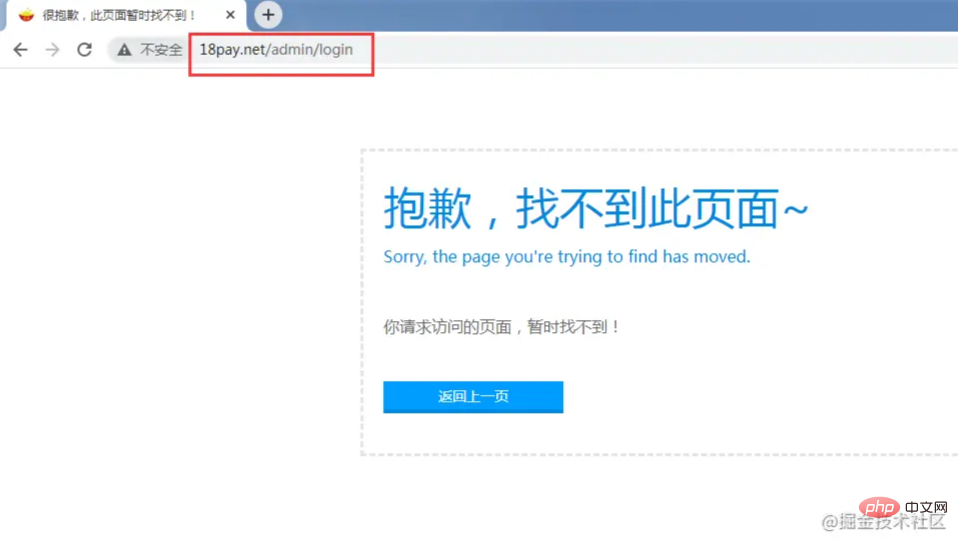Home >PHP Framework >ThinkPHP >How to configure routing in ThinkPHP to hide the background!
ThinkPHPHow to hide the background? The following article will introduce to you how ThinkPHP cleverly uses routing rules to hide the background, making your website more secure!

As we all know, if the backend module of the thinkphp framework is named admin, you can directly use http://domain name/admin This access method is very convenient, but it also has great security risks. Hackers can easily guess your backend and then brute force the backend. So is there any way to solve this hidden danger? Let's discuss how to use routing rules to modify the backend path to prevent hackers from knowing our backend entrance. There are many tutorials on hiding the background admin on the Internet, but the really useful one is this routing rule method.

1,

2. The key code to save the settings is as follows:
if(request()->isPost()) {
$data=input('post.');
//获取系统全部模块名
$system_module = [];
foreach (scandir(APP_PATH) as $dir) {
if($dir == '.' || $dir == '..') {
continue;
}
if(is_dir(APP_PATH.$dir)) {
array_push($system_module, $dir);
}
}
foreach ($data as $key => $vo) {
if($key == 'admin_module' && $vo != 'admin' && in_array($vo, $system_module)) {
$this->error('后台地址不能与现有系统模块名同名');
}
}
}Notes:
- admin_module is my database The key
- APP_PATH that saves the background module name is a constant of thinkphp5.0 version. If it is other versions, please modify it yourself.
1. The main structure of the config data table is as follows:
DROP TABLE IF EXISTS `config`; CREATE TABLE `config` ( `id` int(11) NOT NULL AUTO_INCREMENT, `key` varchar(255) DEFAULT NULL, `val` text, PRIMARY KEY (`id`) ) ENGINE=InnoDB AUTO_INCREMENT=1 DEFAULT CHARSET=utf8;
2. sysconfig($name) method: Get the corresponding value based on the key name
<?php
use think\Cache;
use app\common\model\Config;
/**
* 获取或配置系统参数
* @param string $name 参数名称
* @return string
*/
function sysconfig($name) {
$config = Cache::get('config');
if (empty($config)) {
$config = Config::column('key,val');
Cache::set('config',$config,1800);//缓存30分钟
}
return isset($config[$name]) ? $config[$name] : '';
}Supplement:
1. If it is only a system for personal use, If you don’t want to be so troublesome, you can also add the following configuration directly to config.php:
return [ // +---------------------------------------------------------------------- // | 应用设置 // +---------------------------------------------------------------------- // 后台模块名 'admin_module' => 'myadmin', ]2, and then call it directly in the project:
$admin_module = Config('admin_module');
<?php
use think\route;
$route_config = [
'index'=>'index/index',
];
//1.获取后台模块
$admin_module = sysconfig('admin_module');
if ($admin_module == '') {
$admin_module = 'admin';
}
//2.设置后台路由
if ($admin_module != 'admin') {
$admin_route_config = [
//路由禁止:原理是把它指到非登陆地址,在没有登陆情况下,跳转到404页面;
'admin/$' => 'admin/login/jump',
'admin/login$' => 'admin/login/jump',
'admin/login/index' => 'admin/login/jump',
$admin_module . '/$' => 'admin/login/index',
];
$route_config = array_merge($route_config, $admin_route_config);
}
return $route_config;1. This jump() method is actually the designated method for prohibiting routing in our third step
public function jump() {
if(!Session::has('uid')) {
$request = Request::instance();
if(sysconfig('admin_module') == 'admin' || sysconfig('admin_module') == '') {
$this->redirect('@admin/login/index');
} else {
header("HTTP/1.1 404 Not Found");
return $this->fetch(APP_PATH.'/404.html');
}
} else {
$this->redirect('@admin/index/index');
}
}2. The code in jump() above has only one function, that is If you are not logged in, accessing a prohibited route will jump to the 404 page, as follows:

3. The 404.html page is placed in the application directory, and the code is as follows :
<!DOCTYPE html PUBLIC "-//W3C//DTD XHTML 1.0 Transitional//EN" "http://www.w3.org/TR/xhtml1/DTD/xhtml1-transitional.dtd">
<html xmlns="http://www.w3.org/1999/xhtml">
<head>
<meta http-equiv="Content-Type" content="text/html; charset=utf-8" />
<title>很抱歉,此页面暂时找不到!</title>
<style type="text/css">
body {margin: 0px; padding:0px; font-family:"微软雅黑", Arial, "Trebuchet MS", Verdana, Georgia,Baskerville,Palatino,Times; font-size:16px;}
div{margin-left:auto; margin-right:auto;}
a {text-decoration: none; color: #1064A0;}
a:hover {color: #0078D2;}
img { border:none; }
h1,h2,h3,h4 {
/* display:block;*/
margin:0;
font-weight:normal;
font-family: "微软雅黑", Arial, "Trebuchet MS", Helvetica, Verdana ;
}
h1{font-size:44px; color:#0188DE; padding:20px 0px 10px 0px;}
h2{color:#0188DE; font-size:16px; padding:10px 0px 40px 0px;}
#page{width:910px; padding:20px 20px 40px 20px; margin-top:80px;}
.button{width:180px; height:28px; margin-left:0px; margin-top:10px; background:#009CFF; border-bottom:4px solid #0188DE; text-align:center;}
.button a{width:180px; height:28px; display:block; font-size:14px; color:#fff; }
.button a:hover{ background:#5BBFFF;}
</style>
</head>
<body>
<div id="page" style="border-style:dashed;border-color:#e4e4e4;line-height:30px;">
<h1>抱歉,找不到此页面~</h1>
<h2>Sorry, the page you're trying to find has moved. </h2>
<font color="#666666">你请求访问的页面,暂时找不到!</font><br /><br />
<div class="button">
<a href="javascript:;" onClick="javascript :history.back(-1);" title="返回上一页">返回上一页</a>
</div>
</div>
</body>
</html>4. How to log out
public function logout() {
if(Session::has('adminid')) {
Session::delete('adminid');
}
$this->redirect(url('@'.sysconfig('admin_module')));
}Original address: https://juejin.cn/post/6981428649765371940
More programming For related knowledge, please visit: Introduction to Programming! !
The above is the detailed content of How to configure routing in ThinkPHP to hide the background!. For more information, please follow other related articles on the PHP Chinese website!